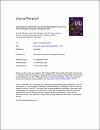Seroprevalence of West Nile Virus among Healthy Blood Donors from Different National Populations Residing in Qatar
| Author | Soha R., Dargham |
| Author | Al-Sadeq, Duaa W. |
| Author | Yassine, Hadi M. |
| Author | Ahmed, Muna |
| Author | Kunhipurayil, Hasna |
| Author | Humphrey, John M. |
| Author | Abu-Raddad, Laith J. |
| Author | Nasrallah, Gheyath K. |
| Available date | 2020-11-29T05:10:46Z |
| Publication Date | 2020-11-25 |
| Publication Name | International Journal of Infectious Diseases |
| Identifier | http://dx.doi.org/10.1016/j.ijid.2020.11.175 |
| Citation | Dargham SR, Al-Sadeq DW, Yassine HM, Ahmed M, Kunhipurayil H, Humphrey JM, Abu-Raddad LJ, Nasrallah GK, Seroprevalence of West Nile Virus among Healthy Blood Donors from Different National Populations Residing in Qatar, International Journal of Infectious Diseases (2020), doi: https://doi.org/10.1016/j.ijid.2020.11.175 |
| ISSN | 1201-9712 |
| Abstract | ObjectiveTo estimate the age- and nationality-specific West Nile virus (WNV) seroprevalence in select Middle East and North Africa (MENA) populations residing in Qatar. MethodsSera were collected from male blood donors attending Hamad Medical Corporation. A total of 1,948 sera were tested for anti-WNV antibodies using Serion ELISA classic IgG and IgM kits. ResultsOverall, seroprevalence estimates of WNV-specific IgG and IgM antibodies were 10.4% and 3.3%, respectively. Country-specific WNV-specific IgG seroprevalence was estimated to be 37.0% (34/92) in Sudanese, 33.0% in Egyptians (66/200), 13.0% (26/200) in Indians, 10.6% (11/104) in Iranians, 10.2% (14/137) in Yemenis, 9.2% (18/195) in Pakistanis, 7.0% ( 14/199) in Jordanians, 5.4% (6/111) in Filipinos, 2.5% (5/200) in Palestinians, 2.5% (5/200) in Syrians, 1.5% (3/200) in Qataris, and 0.9% (1/110) in Lebanese. Seroprevalence of WNV-specific IgM was lowest in Iranians (0/77), Lebanese (0/108), and Filipinos (0/107) at 0.0%, and was highest in Sudanese at 10.0% (8/80). While there seemed to be apparent trends in the prevalence of WNV-IgM and WNV-IgG antibodies, none of these trends were found statistically significant. ConclusionThe findings support the circulation of WNV in human populations in the different countries of the MENA region. Seroprevalence was highest in Sudanese and Egyptians and lowest in Qataris and nationals of the Levant. The findings call for further animal, vector, and human studies, such as studying the actual prevalence of the viral RNA in blood donors to assess risk of viral transmission through blood donation and for a better characterization of the epidemiology of this infection in this part of the world. |
| Sponsor | Qatar University internal grant (QUCG-CHS-19/20-1), Qatar National Research Fund (UREP20-020-3-003 and NPRP 9-040-3-008), and the Biomedical Research Program at Weill Cornell Medicine-Qatar. |
| Language | en |
| Publisher | Elsevier |
| Subject | Arbovirus prevalence Vector-borne disease Mosquito West Nile Fever Zoonosis Qatar |
| Type | Article |
| Open Access user License | http://creativecommons.org/licenses/by-nc-nd/4.0/ |
Check access options
Files in this item
This item appears in the following Collection(s)
-
Biomedical Research Center Research [838 items ]
-
Biomedical Sciences [847 items ]
-
Medicine Research [1913 items ]



